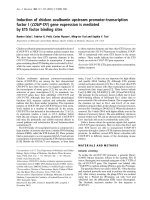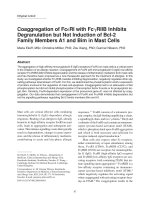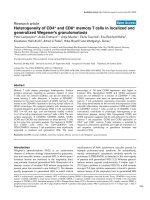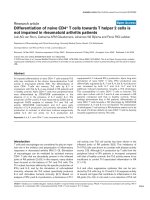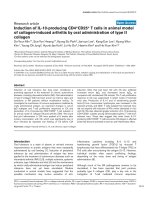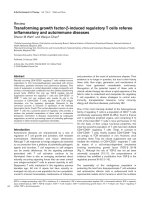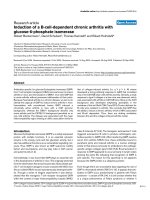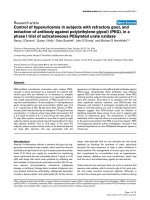Báo cáo y học: " Induction of IL-10-producing CD4+CD25+ T cells in animal model of collagen-induced arthritis by oral administration of type II collagen" pptx
Bạn đang xem bản rút gọn của tài liệu. Xem và tải ngay bản đầy đủ của tài liệu tại đây (833.19 KB, 7 trang )
Introduction
Oral tolerance is a state of absent or minimal immune
responsiveness to protein antigens that were repeatedly
administered by oral feeding [1]. Induction of peripheral
tolerance by oral administration of antigen has been
applied to the treatment of autoimmune diseases such as
rheumatoid arthritis (RA) [2,3], multiple sclerosis, systemic
sclerosis, type I diabetes and iritis [4], but the mechanisms
by which orally administered antigen can induce peripheral
tolerance have not yet been elucidated. Studies
conducted in animal models have suggested that the
possible mechanism may involve secretion of anti-
inflammatory cytokines including IL-4, IL-10 and
transforming growth factor (TGF)-β by mucosal T
lymphocytes that have differentiated into T-helper (Th)2 or
Th3 cells after encountering the antigen [5–7]. However,
individual studies often report conflicting findings,
depending on the route, dose and timing of antigen
administration [8].
Although much of the RA pathogenesis remains to be
elucidated, it has been reported that joint proteins,
probably type II collagen (CII), play a key role in the
instigation of T-cell mediated immune responses.
CFA = complete Freund’s adjuvant; CIA = collagen-induced arthritis; CII = type II collagen; ELISA = enzyme-linked immunosorbent assay; FACS =
fluorescence-activated cell sorting; IFN = interferon; IL = interleukin; PBS = phosphate-buffered saline; RA = rheumatoid arthritis; TGF = transform-
ing growth factor; Th = T-helper.
Available online />Research article
Induction of IL-10-producing CD4
+
CD25
+
T cells in animal model
of collagen-induced arthritis by oral administration of type II
collagen
So-Youn Min
1
*, Sue-Yun Hwang
1
*, Kyung-Su Park
2
, Jae-sun Lee
1
, Kang-Eun Lee
1
, Kyung-Wun
Kim
1
, Young-Ok Jung
2
, Hyunk-Jae Koh
2
, Ju-Ho Do
2
, Haerim Kim
2
and Ho-Youn Kim
1,2
1
Rheumatism Research Center, Catholic Research Institute of Medical Science, The Catholic University of Korea, Seoul, Korea
2
Center for Rheumatic Disease, Kangnam St. Mary’s Hospital, The Catholic University of Korea Medical School, Seoul, Korea
*Co-first authors; order can be switched for bibliographic purposes
Corresponding author: Ho-Youn Kim (e-mail: )
Received: 22 Oct 2003 Revisions requested: 2 Dec 2003 Revisions received: 10 Feb 2004 Accepted: 26 Feb 2004 Published: 11 Mar 2004
Arthritis Res Ther 2004, 6:R213-R219 (DOI 10.1186/ar1169)
© 2004 Min et al., licensee BioMed Central Ltd. This is an Open Access article: verbatim copying and redistribution of this article are permitted in
all media for any purpose, provided this notice is preserved along with the article's original URL.
Abstract
Induction of oral tolerance has long been considered a
promising approach to the treatment of chronic autoimmune
diseases, including rheumatoid arthritis (RA). Oral administration
of type II collagen (CII) has been proven to improve signs and
symptoms in RA patients without troublesome toxicity. To
investigate the mechanism of immune suppression mediated by
orally administered antigen, we examined changes in serum
IgG subtypes and T-cell proliferative responses to CII, and
generation of IL-10-producing CD4
+
CD25
+
T-cell subsets in
an animal model of collagen-induced arthritis (CIA). We found
that joint inflammation in CIA mice peaked at 5 weeks after
primary immunization with CII, which was significantly less in
mice tolerized by repeated oral feeding of CII before CIA
induction. Mice that had been fed with CII also exhibited
increased serum IgG
1
and decreased serum IgG
2a
as
compared with nontolerized CIA animals. The T-cell proliferative
response to CII was suppressed in lymph nodes of tolerized
mice also. Production of IL-10 and of transforming growth
factor-β from mononuclear lymphocytes was increased in the
tolerized animals, and CD4
+
T cells isolated from tolerized mice
did not respond with induction of IFN-γ when stimulated in vitro
with CII. We also observed greater induction of IL-10-producing
CD4
+
CD25
+
subsets among CII-stimulated splenic T cells from
tolerized mice. These data suggest that when these IL-10-
producing CD4
+
CD25
+
T cells encounter CII antigen in affected
joints they become activated to exert an anti-inflammatory effect.
Keywords: collagen-induced arthritis, IL-10, oral tolerance, type II collagen
Open Access
R213
R214
Arthritis Research & Therapy Vol 6 No 3 Min et al.
Administration of CII to DBA/1 mice induces polyarthritis
with pathological symptoms similar to those observed in
human RA [9,10]. In order to investigate the cellular
mechanisms that underlie oral tolerance, we studied an
animal model of collagen-induced arthritis (CIA), in which
mice undergo repeated oral administration of CII, and
monitored changes in immune cell function and factors
associated with inflammation. We found that serum levels
of IgG subtypes, as well as the production of IL-10, TGF-β
and IFN-γ, were affected in tolerized mice. We also
noticed greater proportions of IL-10-producing CD4
+
CD25
+
T cells in the Peyer’s patch, mesenteric lymph nodes and
the spleen of tolerized mice. Production of these cells,
exhibiting the characteristics of the Treg subset, was
induced to a significant degree by lymphocytes from
tolerized spleen when stimulated in vitro with CII. We
hypothesize that expansion of these suppressor T cells in
the periphery might have contributed to the reduced
inflammation observed in affected joints.
Materials and methods
Induction of oral tolerance in DBA/1 mice
DBA/1 mice used in this study were fed either with 100 µg
bovine CII (a kind gift from Prof. Andrew Kang, University
of Tennessee) dissolved in 0.05 N acetic acid at 2 mg/ml
(50 µl solution plus 150 µl acetic acid) or with an equal
volume of phosphate-buffered saline (PBS) using an oral
Zonde needle (Natsume, Japan) every 2 days for 2 weeks.
All experimental procedures were examined and approved
by the Animal Research Ethics Committee at The Catholic
University of Korea.
Induction of CIA and evaluation of arthritis
Bovine CII was dissolved in 0.05 N acetic acid at 2 mg/ml
and emulsified with an equal volume of complete Freund’s
adjuvant (CFA). As primary immunization, 0.1 ml of the
emulsion, containing 100 µg CII, was injected into the tails
of DBA/1 mice (both tolerized mice and nontolerized
control mice; n = 6 per group). Two weeks later, a booster
injection consisting of 200 µg CII similarly dissolved and
emulsified 1:1 with incomplete Freund’s adjuvant was
injected into a hind leg. Starting from 2.5 weeks (18 days)
after primary immunization, three independent observers
examined the degree of arthritis three times a week for up
to 11 weeks. The severity of arthritis was represented as
mean arthritic index on a 0–4 scale according to the
following criteria [11]: 0 = no oedema or swelling; 1 =
slight oedema and erythema limited to the foot and/or
ankle; 2 = slight oedema and erythema from the ankle to
the tarsal bone; 3 = moderate oedema and erythema from
the ankle to the tarsal bone; and 4 = oedema and
erythema from the ankle to the entire leg. The sum of
values from three legs, excluding the hind leg into which
CII/incomplete Freund’s adjuvant was injected, was
determined at the time of the second injection. The final
values presented in the Results section represent an
average of the indices recorded by three independent
observers. All experimental procedures were examined
and approved by the Animal Research Ethics Committee
at The Catholic University of Korea.
Analysis of IgG antibody subtypes
Blood samples obtained from each mouse at 3, 5 and
7 weeks after primary immunization were used to
investigate IgG antibody subtype concentrations using the
mouse IgG
1
/IgG
2a
ELISA quantitation kit (Bethyl Lab Co.,
Montgomery, TX, USA). Levels of IgG
1
and IgG
2a
were
measured in mice sera diluted 50,000- to 400,000-fold.
Determination of collagen-specific T-cell proliferative
response
The draining lymph nodes and the spleen were removed
from each mouse and washed twice with PBS. Tissues
were minced and the cells were filtered through a cell
strainer and centrifuged at 1500 rpm at 4°C for 10 min.
The cell pellet was resuspended in RPMI-1640 medium to
a concentration of 1 × 10
5
cells/ml. Cells were than plated
in 96-well microtitre plates at a concentration of 2 × 10
5
cells/well concentration and cultured with 40 µg/well CII
in 0.3 ml Click’s medium supplemented with 0.5% mouse
serum for 3 days. The same amount of ovalbumin was
added instead of CII to control wells. Eighteen hours
before the termination of culture, 0.5 µCi [
3
H]thymidine
(NEN, Boston, MA, USA) was added to each well. Cells
were harvested onto glass fibre filters and counted on a
Matrix-96 direct ionization β counter (Packard Instrument
Co., Downers Grove, IL, USA). The degree of T-cell
proliferation is presented as the stimulation index, which is
calculated by dividing the counts/min in the presence of
CII by the counts/min in the presence of ovalbumin.
Analyses of cytokine production by ELISA
Mononuclear cells were isolated from the Peyer’s patch
and spleen, and cultured at a density of 0.5 × 10
6
cells/ml
in flat-bottomed, 48-well tissue culture plates (Corning,
Corning, NY, USA). After 2 days, culture supernatants
were harvested and stored at –70°C. To determine the
amount of IL-10 and TGF-β in each supernatant, 96-well
ELISA plates were coated with rat antimurine IL-10 and
TGF-β monoclonal antibodies (R&D Systems,
Minneapolis, MN, USA) for 24 hours at 4°C. After
incubating with blocking agents, the plates were
incubated with previously collected supernatants for
1 hour at room temperature. The plates were then washed
and incubated for 1 hour at room temperature with biotin-
conjugated rat antimurine IL-10 and TGF-β monoclonal
antibodies, followed by an alkaline phosphatase-
conjugated goat antibiotin monoclonal antibody (R&D
Systems). The fluorescent substrate for alkaline phospha-
tase (R&D Systems) was used for colour development,
and fluorescence was measured using a microtitre plate
reader (Dynex, Chantilly, VA, USA) at excitation and
R215
emission wavelengths of 450 nm. The amounts of
cytokines present in test samples were determined from
standard curves established with serial dilutions of
recombinant murine IL-10 and TGF-β.
Fluorocytometric analysis of T cells
Single-cell suspensions were prepared from each
lymphoid organ and cultured in 24-well plates at a
concentration of 1 × 10
6
/well with or without 40 µg/well
CII for 3 days. Golgi Stop (Pharmingen, San Diego, CA,
USA) was added 4 hours before the termination of culture.
Cells were subsequently washed and resuspended in
fluorescence-activated cell sorting (FACS) staining buffer
(PBS plus 0.1% bovine serum albumin plus 0.09%
sodium azide), and probed with anti-CD4-perCP and/or
anti-CD25-FITC (Pharmingen) for 30 min at 4°C. Next,
cells were fixed with cytoperm/cytofix (Pharmingen) for
20 min and probed for intracellular cytokines using
phycoerythrin-labelled anti-IL-10 antibody, anti-IFN-γ
antibody, or isotype control antibody (Pharmingen) for
30 min at room temperature. Finally, cells were washed
with PBS and analyzed on a FACScalibur flow cytometer
(Becton Dickinson, San Jose, CA, USA).
Statistical analysis
Experimental findings are presented as mean ± standard
deviation. Statistical significance was determined by
Student’s t-test using the SPSS program (version 10.0;
SPSS Inc, Chicago, IL, USA). P < 0.05 was considered
statistically significant.
Results
Inhibition of arthritis development in tolerized CIA mice
The severity of arthritis remained low both in the tolerized
and nontolerized CIA mice until 4 weeks after primary
immunization with CII/CFA (Fig. 1). The average arthritis
index in the nontolerized mice began to increase after
week 4, reaching a peak between weeks 5 and 6 after
primary immunization, and then started to decrease by
week 8, and then persisted at an almost constant level
until the 11th week. The arthritis index in the tolerized
group also peaked between 5 and 6 weeks after primary
immunization, but the level was significantly lower than
that in the nontolerized CIA mice throughout the period of
examination. Mice tolerized by oral CII feeding also
exhibited an earlier decrease in their mean arthritis index,
which began at week 7 and continued gradually
thereafter.
Changes in the serum level of IgG subtypes in tolerized
mice
Among three subtypes of IgG, IgG
1
is reported to be
associated with anti-inflammatory actions, whereas IgG
2a
is known to be a mediator of inflammation. Likewise, the
level of IgG
2a
has been shown to be significantly
increased in DBA/1 mice with CIA [12,13]. We investiga-
ted the change in the concentration of serum IgG sub-
types at 3, 5 and 7 weeks after primary immunization
(Fig. 2). Serum IgG
1
concentration was greater in tolerized
mice than in nontolerized CIA mice (104.6 ± 21 ng/ml
versus 76.3 ± 15 ng/ml; P < 0.05; Fig. 2a). On the other
hand, serum IgG
2a
concentration was significantly lower in
the tolerized group when examined at both 3 weeks and
5 weeks after primary immunization (86.6 ± 17.5 ng/ml
versus 114.7 ± 12.2 ng/ml; P < 0.05; Fig. 2b). Notably,
the average level of IgG
2a
in the tolerized mice was about
twofold lower than in the nontolerized CIA mice at 5 weeks
after primary immunization. After week 11, when the mean
arthritic index had already dwindled, no further significant
differences in IgG subtype concentrations were observed
between the two groups (data not shown).
Proliferation response to CII by T cells isolated from the
draining lymph nodes and spleens of tolerized mice
We then investigated the proliferation of T cells isolated
from the draining lymph node and spleen on in vitro
antigenic simulation with CII. At 3 and 5 weeks after
primary immunization with CII/CFA, the T-cell proliferative
response to CII was about 25% lower in cells isolated
from the draining lymph node of orally tolerized mice than
in cells from the nontolerized CIA mice (stimulation index
8.2 ± 2.3 versus 6.2 ± 3.5; P < 0.05). After week 7 no
Available online />Figure 1
Suppression of arthritis in mice that received oral type II collagen (CII)
before arthritis induction. Mice that were given six consecutive
administrations of 100 µg CII orally before induction of arthritis
exhibited a marked reduction in arthritis index as compared with
nontolerized collagen-induced arthritis (CIA) controls throughout the
period of examination (i.e. from 2 to 11 weeks after the primary CII
immunization for CIA induction). The data represent average values
from 15 individual mice in each group.
significant difference was noticed between draining lymph
node T cells from the two groups (Fig. 3a). Splenic T cells
from orally tolerized mice also exhibited a lower
proliferative response to CII than did cells from
nontolerized CIA mice when examined at 5 weeks after
primary immunization. By week 7 proliferation on CII
stimulation decreased to approximately 50% of the value
observed at week 5 in both groups (Fig. 3b).
Changes in the production of IL-10, TGF-
ββ
and IFN-
γγ
by
lymphocytes of orally tolerized mice
To examine the effect of oral CII administration on the
activity of immune cells, we measured the production of
IL-10 and TGF-β by mononuclear lymphocytes isolated
from the Peyer’s patch and spleen of each mouse. As
shown in Fig. 4, production of both IL-10 and TGF-β was
increased in lymphocytes isolated from the Peyer’s patch
and the spleen of tolerized mice as compared with
lymphocytes from nontolerized CIA mice or from normal
DBA/1 mice. Although the level of TGF-β production in
cells from nontolerized CIA mice was similar to that in
cells from normal DBA/1 mice, the production of IL-10
was slightly greater in cells from nontolerized CIA than in
cells from normal DBA/1 mice.
We then compared the level of IFN-γ production from
antigen stimulated CD4
+
T cells isolated from the Peyer’s
patch, mesenteric lymph nodes and spleens of tolerized
and nontolerized mice (Table 1) by FACS analyses using
Arthritis Research & Therapy Vol 6 No 3 Min et al.
R216
Figure 2
Serum levels of (a) IgG
1
and (b) IgG
2a
subtypes in tolerized and
nontolerized collagen-induced arthritis (CIA) mice. When examined at
3, 5 and 7 weeks after primary immunization, mice that received oral
type II collagen (CII) exhibited higher serum levels of IgG
1
than did
nontolerized mice at all three time points, whereas the IgG
2a
level was
lower in the tolerized group. The data represent average values from
15 mice in each group.
Figure 3
T-cell proliferative response to antigenic stimulation with type II
collagen (CII). T cells were isolated from draining lymph nodes and
spleens of mice killed at 3, 5 and 7 weeks after primary immunization,
and were cultured for 72 hours in the presence of 40 µg/ml CII. Panels
show changes in the stimulation index (SI) of T cells isolated from (a)
draining lymph node and (b) spleen. The data represent average
values from 15 mice in each group.
monoclonal antibodies against CD4 and intracellular IFN-γ.
When examined ex vivo, no apparent differences in IFN-γ
production were observed between the two groups.
When these cells were stimulated in vitro with 40 µg/ml
CII for 3 days, the level of IFN-γ synthesis increased up to
10-fold in nontolerized CIA mice but remained virtually
unchanged in tolerized animals.
Induction of IL-10-producing CD4
+
CD25
+
population
from splenic T cells of orally tolerized mice by
in vitro
CII stimulation
To identify any possible involvement of particular T-cell
subsets that are known to exert immune suppressive
functions [6,14], we compared the proportion of IL-10-
producing CD4
+
CD25
+
T lymphocytes between tolerized
and nontolerized mice. For this, single-cell preparations
from the Peyer’s patch, mesenteric lymph node and
spleen extracted at 5 weeks after primary immunization
were cultured in vitro with or without CII stimulation for
3 days, and analyzed using triple-colour FACS. The
proportion of IL-10-producing CD4
+
CD25
+
cells was
higher in tolerized mice than in nontolerized CIA mice and
normal DBA/1 mice in all three organs examined (Table 2).
In normal DBA/1 mice the proportion of IL-10-producing
CD4
+
CD25
+
cells remained unchanged from baseline in
all three organs examined, regardless of whether in vitro
CII stimulation was applied. The proportion of IL-10-
producing CD4
+
CD25
+
cells in tolerized mice exhibited a
modest increase in the Peyer’s patch and mesenteric
lymph nodes when stimulated in vitro with CII; however,
the degree of enrichment was not significantly different
from that in nontolerized CIA mice. On the other hand, in
vitro CII stimulation induced a much steeper elevation in
IL-10-producing CD4
+
CD25
+
population in the spleens
of tolerized mice (from 2.95 ± 1.62% to 15.5 ± 4.50%)
than in the nontolerized group (from 0.15 ± 0.07% to
3.85 ± 0.63%). Differences between the enrichment in
T-cell subsets in the spleen are shown in a representative
dot plot (Fig. 5).
Discussion
Treatment of autoimmune diseases by induction of oral
tolerance is attractive because of the few side effects and
easy clinical implementation of this approach. Although
protein antigens administered orally are degraded quickly
in the digestive system and their effects do not last long,
we previously overcame these drawbacks by encapsula-
ting CII – the major cartilage autoantigen in RA – in a
polymer complex [15]. In the present study we attempted
to improve our basic understanding of the immune cell
functions that participate in the process of induction of
oral tolerance. Because most of the previous studies that
addressed the mechanism underlying oral tolerance were
conducted in transgenic animal models that overexpress
T-cell clones that recognize experimental antigens such as
ovalbumin, it is difficult to relate their findings to the
Available online />R217
Figure 4
Comparisons of (a) IL-10 and (b) transforming growth factor (TGF)-β
production by mononuclear lymphocytes from lymphoid organs of
tolerized and nontolerized mice. Organs were extracted from normal
DBA/1, and tolerized and nontolerized collagen-induced arthritis (CIA)
mice at 5 weeks after primary immunization with type II collagen (CII)
for induction of CIA. Mononuclear cells were isolated from the Peyer’s
patch and the spleen, and production of IL-10 and TGF-β was
assessed by sandwich ELISA analyses of culture supernatants. The
data represent average values from three independent measurements.
clinical situation [16]. In the present study we examined
the changes in immune function that are involved in the
induction of peripheral tolerance in an orally tolerized
mouse model of arthritis.
Our findings indicate that the serum levels of pro-
inflammatory and anti-inflammatory IgG subtypes are
differentially modulated in mice that have undergone
repeated oral administration of CII. We also found that,
although the production of IFN-γ by CD4
+
T cells from
tolerized mice on CII stimulation is reduced, the production
of IL-10 and TGF-β is increased not only in cells from the
site of initial contact with the oral antigen (i.e. the Peyer’s
patch) but also in cells from lymph nodes and the spleen.
That in vitro restimulation with CII generated significant
enrichment in IL-10-producing CD4
+
CD25
+
T cells among
lymphocytes from tolerized spleen is particularly interesting.
We hypothesize that by the time these IL-10-producing
cells have reached the spleen through peripheral blood,
they have also been transferred to the affected joints where
CII is accumulated from cartilage degradation and have
begun to alleviate inflammation.
Many recent studies have reported that IL-10, a major anti-
inflammatory cytokine secreted by Th2 lymphocytes,
contributes to the process of peripheral tolerance [1,6].
Our data suggest that the establishment of CII-mediated
tolerance to arthritic inflammation involved, among other
mechanisms of immunosuppression, participation of
CD4
+
CD25
+
T cells and their production of IL-10 in
peripheral lymphoid organs. However, roles for Th3 cells
(known for their production of TGF-β [17,18]) and for Tr1
Arthritis Research & Therapy Vol 6 No 3 Min et al.
R218
Table 1
IFN-
γγ
production by CD4
+
T cells in lymph nodes and the
spleen
% IFN-γ-positive cells
Site Without CII stimulation With CII stimulation
Peyer’s patch
CIA 3.4 ± 0.22 26.6 ± 0.6
Tolerized 4.6 ± 0.1 8.9 ± 0.2
Mesentric lymph node
CIA 3.3 ± 0.4 34 ± 0.2
Tolerized 2.3 ± 0.5 5.6 ± 0.8
Spleen
CIA 5.4 ± 0.01 42.6± 0.1
Tolerized 4.5 ± 0.2 5.3 ± 0.02
Values are expressed as mean ± standard deviation, calculated from
three independent measurements. CIA, collagen-induced arthritis; CII,
type II collagen.
Table 2
Proportion of IL-10-producing CD4
+
CD25
+
T cells in lymph
nodes and spleen
% CD4
+
CD25
+
IL-10-positive cells
Site Without CII stimulation With CII stimulation
Peyer’s patch
Normal 0.17 ± 0.12 0.14 ± 0.06
CIA 1.6 ± 0.7 3.6 ± 0.2
Tolerized 2.4 ± 1.6 6.8 ± 1.2
Mesentric lymph node
Normal 0.35 ± 0.35 0.5 ± 0.28
CIA 0.85 ± 0.35 1.8 ± 0.5
Tolerized 2.95 ± 1.06 7.9 ± 1.48
Spleen
Normal 0.13 ± 0.04 0.25 ± 1.3
CIA 0.15 ± 0.07 3.85 ± 0.63
Tolerized 2.95 ± 1.62 15.5 ± 4.5
Values are expressed as mean ± standard deviation, calculated from
three independent measurements. CIA, collagen-induced arthritis; CII,
type II collagen.
Figure 5
Induction of IL-10-producing CD4
+
CD25
+
T cells in the spleen of
tolerized mice. The proportion of IL-10-producing CD4
+
CD25
+
T cells
was analyzed by triple-colour fluorescence-activated cell sorting
(FACS) analyses. Single-cell suspension was prepared from the
spleens of normal DBA/1, and tolerized and nontolerized collagen-
induced arthritis (CIA) mice at 5 weeks after primary immunization.
Cells were first gated for CD4
+
proportions, and subsequently
analyzed for surface expression of CD25
+
and for the presence of
intracellular IL-10. A representative dot plot chosen from three
independent measurements (summarized in Table 2) is shown.
cells (which are characterized by low proliferation and
high production of IL-10 [19–21]) are equally implicated in
the process of induction of peripheral tolerance. We
observed elevated production of TGF-β from tolerized
lymphocytes as well, and it would therefore be very
interesting to investigate the role of Th3 cells. In order to
further define the characteristics of cells that exert
immunosuppressive functions, we are in the process of
examining the expression of CD62L and CD45RB, which
are accepted as additional phenotypic markers for
regulatory T cells [22,23], and the effect of transferring T
cells into nontolerized CIA mice.
Conclusion
We observed a greater proportion of IL-10-producing
CD4
+
CD25
+
T cells in mice that had undergone repeated
oral administration of CII. Together with increased
production of IL-10 and TGF-β in peripheral lymphoid
organs, induction of this suppressor population is believed
to block the induction of IFN-γ from CII-stimulated CD4
+
cells. Because little is known about the cellular
mechanisms that underlie orally induced tolerance in non-
transgenic systems, our findings provide important basic
information on the generation of peripheral immune
tolerance. Once merged with findings on possible inter-
cellular cooperation between CII-specific T cells and other
participants such as dendritic cells, these data will provide
a basis for more effective application of oral tolerance
induction in RA patients.
Competing interests
None declared.
Acknowledgements
This study was supported by the 2002 Specialized Research Center
(SRC) grant from the Korean Science and Engineering Foundation
(KOSEF) to the Rheumatism Research Center (RhRC) at The Catholic
University of Korea.
References
1. Weiner HL, Friedman A, Miller A, Khoury SJ, al-Sabbagh A, Santos
L, Sayegh M, Nussenblatt RB, Trentham DE, Hafler DA: Oral toler-
ance: immunologic mechanisms and treatment of animal and
human organ-specific autoimmune diseases by oral adminis-
tration of autoantigens. Annu Rev Immunol 1994, 12:809-837.
2. Trentham DE, Dynesius-Trentham RA, Orav EJ, Combitchi D,
Lorenzo C, Sewell KL, Hafler DA, Weiner HL: Effect of oral
administration of type II collagen on rheumatoid arthritis.
Science 1993, 261:1727-1730.
3. Barnett ML, Kremer JM, St Clair EW, Clegg DO, Furst D,
Weisman M, Fletcher MJ, Chasan-Taber S, Finger E, Morales A,
Le CH, Trentham DE: Treatment of rheumatoid arthritis with
oral type II collagen. Results of a multicenter, double-blind,
placebo-controlled trial. Arthritis Rheum 1998, 41:290-297.
4. Strobel S, Mowat AM: Immune responses to dietary antigens:
oral tolerance. Immunol Today 1998, 19:173-181.
5. Fishman-Lobell J, Freidman A, Weiner HL: Different kinetic pat-
terns of cytokine gene expression in vivo in orally tolerant
mice. Eur J Immunol 1994, 24:2720-2724.
6. Tsuji NM, Mizumachi K, Kurisaki J: Interleukin-10 secreting
Peyer’s patch cells are responsible for active suppression in
low-dose oral tolerance. Immunology 2001, 103:458-464.
7. Weiner HL: Oral tolerance: immune mechanisms and treatment
of autoimmune diseases. Immunol Today 1997, 18:335-343.
8. Friedman A, Weiner HL: Induction of anergy or active suppres-
sion following oral tolerance is determined by antigen
dosage. Proc Natl Acad Sci USA 1994, 91:6688-6692.
9. Trentham DE, Townes AS, Kang AH: Autoimmunity to type II
collagen: an experimental model of arthritis. J Exp Med 1977,
146:857-868.
10. Stuart JM, Huffstutter EH, Townes AS, Kang AH: Incidence and
specificity of antibodies to type I, II, III, IV, and V collagen in
rheumatoid arthritis and other rheumatic disease as mea-
sured by 125I-radioimmunoassay. Arthritis Rheum 1983, 26:
832-840.
11. Rosloniec EF, Cremer M, Kang A, Myers LK: Collagen-induced
arthritis. In: Current Protocols in Immunology, vol 3. Edited by
Coligan JE, Kruisbeek AM, Margulies DH, Shevach EM, Strober
W. New York: Wiley; 1996:15.5.1-15.5.19.
12. Seetharaman R, Mora AL, Nabozny G, Boothby M, Chen J:
Essential role of T-cell NF-kappa B activation in collagen-
induced arthritis. J Immunol 1999, 163:1577-1583.
13. Butler DM, Malfait AM, Maini RN, Brennan FM, Feldmann M: Anti-
IL-12 and anti-TNF antibodies synergistically suppress the
progression of murine collagen-induced arthritis. Eur J
Immunol 1999, 29:2205-2212.
14. Piccirillo CA, Letterio JJ, Thornton AM, McHugh RS, Mamura M,
Mizuhara H, Shevach EM: CD4
+
CD25
+
regulatory T-cells can
mediate suppressor function in the absence of transforming
growth factor 1 production and responsiveness. J Exp Med
2002, 196:237-245.
15. Kim WU, Park JS, Ryoo JW, Kim J, Youn J, Kim SH, Min SY, Bae
EY, Lee WK, Hwang SY, Park SH, Cho CS, Kim HY: Suppres-
sion of collagen induced arthritis by single administration of
poly(lactic-co-glycolic acid) nanoparticles entrapping CII: a
novel therapeutic strategy for oral tolerance. Arthritis Rheum
2002, 46:1109-1120.
16. Gonnella PA, Chen Y, Inobe J, Komagata Y, Quartulli M, Weiner
HL: In situ immune response in gut-associated lymphoid
tissue (GALT) following oral antigen in TCR-transgenic mice. J
Immunol 1998, 160:4708-4718.
17. Shi HN, Grusby MJ, Nagler-Anderson C: Orally induced periph-
eral nonresponsiveness is maintained in the absence of func-
tional Th1 or Th2 cells. J Immunol 1999, 162:5143-5148.
18. Oldenhove G, de Heusch M, Urbain-Vansanten G, Urbain J, Mal-
iszewski C, Leo O, Moser M: CD4
+
CD25
+
regulatory T cells
control T helper cell type 1 responses to foreign antigens
induced by mature dendritic cells in vivo. J Exp Med 2003,
198:259-266.
19. Wakkach A, Fournier N, Brun V, Breittmayer JP, Cottrez F, Groux
H: Characterization of dendritic cells that induce tolerance
and T regulatory 1 cell differentiation in vivo. Immunity 2003,
18:605-617.
20. Levings MK, Bacchetta R, Schulz U, Roncarolo MG: The role of
IL-10 and TGF-beta in the differentiation and effector function
of T regulatory cells. Int Arch Allergy Immunol 2002, 129:263-
276.
21. Mallat Z, Gojova A, Brun V, Esposito B, Fournier N, Cottrez F,
Tedgui A, Groux H: Induction of a regulatory T cell type 1
response reduces the development of atherosclerosis in
apolipoprotein E-knockout mice. Circulation 2003, 108:1232-
1237.
22. Annacker O, Burlen-Defranoux O, Pimenta-Araujo R, Cumano A,
Bandeira A: Regulatory CD4 T cells control the size of the
peripheral activated/memory CD4 T cell compartment. J
Immunol 2000, 164:3573-3580.
23. Jump RL Levine AD: Murine Peyer’s patches favor develop-
ment of an IL-10 secreting, regulatory T cell population. J
Immunol 2002, 168:6113-6119.
Correspondence
Ho-Youn Kim, MD PhD, Rheumatism Research Center (RhRC),
Catholic Institutes of Medical Science, The Catholic University of
Korea, 505 Banpo-Dong, Seocho-Ku, Seoul 137-701, Korea. Tel: +82
2 590 2702; fax: +82 2 537 4673; e-mail:
Available online />R219


